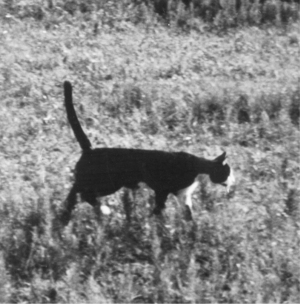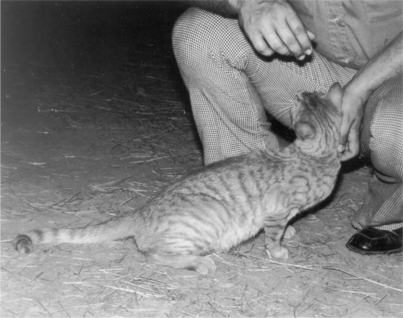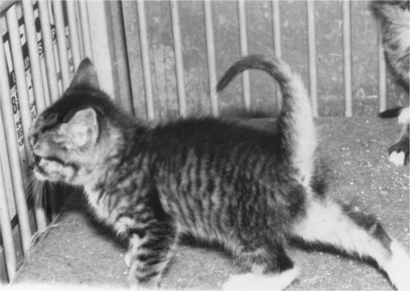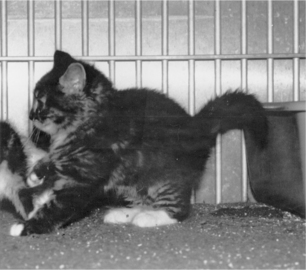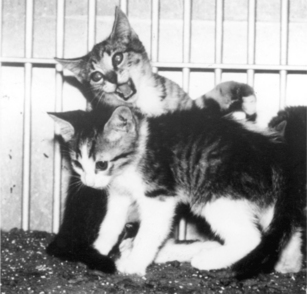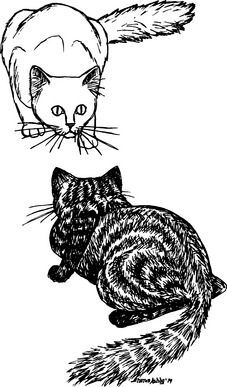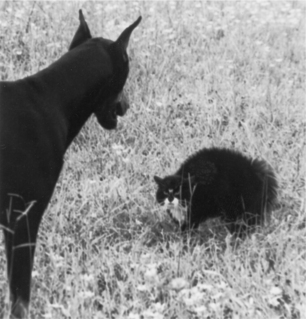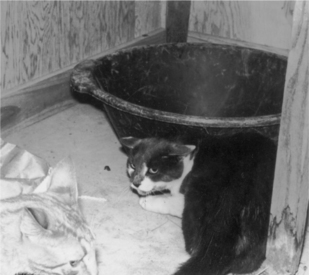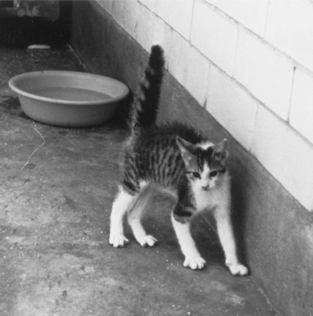Chapter 3 Feline Communicative Behavior
Intraspecies communication takes three major forms: vocal expression, body postures, and visual or olfactory marks. For most animals, body language is the primary messenger, not vocalizations. Chemical communications are often underappreciated by humans. Interspecies communication is more complicated than intraspecies communication because animals of different species generally are not considered to have the innate ability to understand the communications of each other. However, because humans can learn many feline signals, understanding and communication between people and cats is possible.
Vocal Communication
Vocal communications are used to transmit general messages and are not associated with the complexities typically found in human communication. Both vocalizations and marking behaviors, which are discussed later in this chapter, are important tools for the relatively asocial cat; these methods of communication enable an individual to determine if there are any other cats nearby and can thus help prevent direct confrontations. Distance-reducing vocal patterns in response to humans generally do not occur if the distance between the cat and the human is greater than 8 feet.66 The variations of tonal elements during specific-goal emotional states result from changes in the laryngopharynx due to touch reception and tension variations rather than from oral position variations typical in human speech.66,83 Phonetically distinct sounds have been carefully differentiated and placed into one of three groups, depending on how the sound is produced (see Appendix A). Spectrogram analysis recognized 23 patterns that could be divided into two major types of cat vocalizations. Pure calls are homogeneous, whereas complex ones have major changes in frequency ranges, harmonic structures, or pulse modulations.20 Postural communication might also be important in modulating vocal signals.20 These could include such things as position of the ears or piloerection. Although kittens can recognize familiar voices by 4 weeks of age, they usually do not take specific notice of one another’s vocal communication patterns until their ninth week.66
Murmur Patterns
Murmur vocalizations involve sounds a cat produces while its mouth is closed.66
Acknowledgment
The cat that is very bonded to its owner may use a single short murmur of “acknowledgment” when it visualizes something it is about to receive.66 This trill vocalization implies a friendly approach. More than 90% of the time it occurs as the cat is moving, and more than half of the time this is when the cat is changing elevation.12 The acknowledgment sound does not start until sometime after the twelfth week of age.
Call
The feline “call” sound is used primarily to draw someone or something toward the cat; it is also the female’s signal that she is ready to mate.27,28,66 Variations include the coaxing sounds used by a tomcat to notify females that he is ready to mate, to invite young males out to fight, and to announce his presence to other males. This advertising sound is not used by all South American domestic cats, indicating that a learning component may be present in vocalization.79
Grunt
The “grunt” sound, present at birth, generally disappears at maturity, but an occasional adult will voice a grunt when particularly baffled by a difficult obstacle.66
Purr
The “purr” has been described in a number of ways, from mhrn, the most common, to brrp and chirp.16 By 2 days of age the purr is present and is produced by both nursing kittens and the queen. The queen uses the purr initially when approaching her kittens.16 It then serves as a form of communication between them (vocal for the queen and tactile for the kittens). The young kittens will stop the purr only for swallowing.66 The frequency of its use increases as the queen adopts a lactation position, as the kittens nuzzle her fur, or if the queen shifts position while nursing her young.43
As the kitten matures the purr can develop several other inflections and meanings. A “greeting” or request vocalization is an expanded form of a single inhalation segment of the purr. In the kitten this purring vocalization increases in intensity until it reaches the greeting level by about the third week of life, when it may alert other kittens as the first reaches the queen to nurse.25,66,67 This sound, although usually short, can be prolonged sequences of individual purr segments, as when a cat approaches from a distance. The “request” purr for food or attention develops after the twelfth week66 and becomes adultlike by 20 weeks.67
A cat may purr in almost any situation, including just before death following a chronic disease. This may reflect a state of euphoria, perhaps resulting from an endorphin release. A similar sensation has been experienced by terminally ill humans. Experiences that are interpreted to be either pleasurable or distressing may also be accompanied by purring vocalizations. The purr has been equated with the human smile. This may be fairly accurate, although anthropomorphic. Just as people smile when they are happy, are fearful, or want something, cats too are most likely to purr in these situations. Studies show that it is very common for the cat to produce an inaudible purr in the presence of humans.77
There have been many descriptions of how the purr is generated. Theories include fremitus caused by blood passing through kinetic angulation in major vessels and soft palate vibrations. Electromyographic studies, however, show that the purr results from activation of the intrinsic laryngeal muscles, which results in partial glottal closure and increased transglottal pressure for 20- to 30-ms bursts.77,89 That in turn is controlled by the neural infundibulum.30 The diaphragm is alternately activated to produce the more or less continuous sound.77,89 Inhalation is often the louder, longer, and lower-pitched component of the purr, although there is considerable individual variation. In some cats the exhalation portion of the purr may be the major component. The purring interval is variable and depends on the cat’s intensity of interest.
Vowel Patterns
The five types of sounds produced when the mouth is first opened and then gradually closed are called vowel patterns.66
Anger wail
A common form of vocalization for the young kitten has been termed the anger wail.66 This distress vocalization can be heard as early as the first day of life and seems to be related to the absence of the smell of the mother, littermates, or both. The anger wail is even more common in cold environments and during physical restraint.43 During the first few days, the mean number of distress cries is one or two during a 3-minute period, but this number increases rapidly during the first 5 days of life. It reaches a peak soon after the 2-week-old period, which is the most vocal period of the kitten’s life.78,81 Although the anger wail is first associated with competition during nursing, it later becomes individualized and associated with rough forms of play, fights, and protests.27,66,78
Bewilderment
“Bewilderment” is a minor vowel pattern that first occurs after 79 days of age and has a prolonged or more intense terminal sound. The initial portion of this sound can also indicate high expectations or a lack of confidence if the cat is stressed.66
Complaint
Vocalizations of “complaint” also begin sometime after 79 days of age.22,66 Some cats that express a vocal complaint are apparently satisfied with a human’s verbal sympathy.66
Demand
“Demand,” like several other patterns, is often the intermediate form of a series of vocalizations that increase in intensity with time. Kittens do not acquire this pattern until after 79 days of age.66 Variations by means of voice inflections allow the cat to indicate different moods. In tense situations more stress is given to the initial sound, and the opposite occurs in situations of hopelessness.66 A coaxing variation is soft and begins with a closed mouth. The “whisper” occurs when the cat is aware that it is not advisable to make noise but is unable to suppress the demand.66 That results in a mouthing movement with little or no noise (a “silent meow”). A chirping variation of demand, accompanied by intense tail flicking, is commonly expressed when the cat is highly aroused by the sight of prey. Queens use another form of demand to call their kittens over to observe prey.3 A slower, more drawn-out vocalization is expressed when the cat is absorbed in a goal pursuit. The demand then becomes a “begging demand.”66
Mating cry
The cat can express mild forms of the “mating cry” by gradually closing an open mouth.66 It is a characteristic two-syllable call used by an estrous female.49
Siamese vocalizations
Most of the unusual, excessive, and loud vocalizations associated with the Siamese cat are classified as vowel patterns. The distinctive qualities of these sounds are apparently associated with the same recessive gene that carries their typical pigmentation.93
Strained-Intensity Patterns
Sounds that express an intense emotional state are produced with the mouth held open.66
Growl
The warning “growl” occurs during a slow, steady exhalation. The queen uses this vocalization to scatter her kittens and warn them to seek immediate shelter; if necessary, she reinforces the warning with a bat from her paw. When the queen is particularly alarmed, this vocalization takes on a dog-bark quality.27,28 Young kittens can produce this sound and usually first do so when they have matured enough to escape with pieces of food.66 During a fight, the growl is 400 to 800 Hz in frequency.49
Hiss
“Hiss” and its more intense variation “spit” are involuntary reactions to surprise by an enemy. The sound is produced as air is forced through a small oral opening while the cat is changing positions to view the approacher.66 These vocalizations can occur even before the eyes open in the kitten and are controlled, along with other forms of defensive behavior, by the amygdala and the hypothalamus.
Mating cry
The “mating cry” of the tomcat is an intense form of vocalization, which is probably a highly modified form of demand. Often accompanying this caterwauling cry are the parasympathetic reactions of drooling, increased swallowing, and licking.66
Refusal
“Refusal,” a minor sound that is low and rasping, is generally associated with occasions when a cat draws back from something forced on it.66
Scream
As copulation ends, the female cat vocalizes a form of “scream.” This sudden loud pattern, also termed pain shriek, probably represents a very intense variation of the complaint vocal pattern.66,77 Vaginal stimulation by the penile spines is normally the initiating factor.
Neural Regulation
Several areas of the brain are associated with vocalization, but the periaqueductal gray is the most important site.20,86,87 The lateral tegmentum is associated with the growl, the ventral nucleus III with the scream, the tegmentum and medial lemniscus with the meow,20 the cerebral aqueduct with the purr,2 and the amygdala and hypothalamus with growling and hissing.21
Dopamine and acetylcholine are the two primary neurotransmitters associated with vocal communication. When dopamine is released and reuptake is prevented (D-amphetamine), the cat hisses, spits, and meows.20 Blocking dopamine receptors (bulbocapnine) results in a cat that will vocalize easily and loudly at little disturbances.20 Activation of muscarinic cholinergic receptors in the hypothalamus results in a vocal response.20
Postural Communication
Distance-Reducing Postures
Submissive postures
Submissive postures are of minimal significance and, if present, are less highly developed than those of other species. Submission involves postures that serve mainly to inhibit an attack if flight is not possible. The ears may be flattened back against the cat’s head. This posture is commonly shown by a nonterritorial male or female when approached by the territorial male, which may then use the mounting postures associated with mating on the lower-ranking individual. The mounted individual tolerates mounting only until it can escape. Crouching may also be an invitation to approach, as with a female in heat.28
Active approaches
When one cat is actively approaching another, the tail is held vertically.54 When a cat approaches a generally friendly being, or when a kitten approaches the queen, the vertical tail position is particularly obvious (Figure 3-1). This tail position may have been derived from the queen’s licking of the anogenital area of the kittens,27,28 but more likely it evolved to make the message of benevolence very obvious. Cats often rub against each other or a friendly person. This usually begins with the head and corner of the lips and progresses along the shoulder and rest of the body. It may then be repeated using the other side of the cat’s body.67 At the same time the vertical tail is rubbed against the other cat along its cheek, side, or back.13,53 Eventually the two cats end up with the rear end of one cat near the face of the other and with the tail of the first tilting toward the other cat.
When petted, a friendly cat responds by pushing the petted part of its body closer to the person for contact (Figure 3-2). Thus the cat will extend its pelvic limbs when the base of the tail is rubbed or flex its forelimbs and turn its head for a neck massage.
Play postures
Play postures, described in Chapter 2, are distance reducing, as are play-soliciting postures, such as rolling over to expose the abdominal area. In the dog, that is a submissive posture, but it is seen in the cat only in play solicitation, courtship, and extreme defense.27,28
Rolling
Cats that roll onto their side or back expose the most vulnerable portion of their body, the abdomen, to potential attack. Thus it has been suggested that this is a submissive or greeting posture.14,26,67 The behavior is commonly displayed to adult tomcats. In 795 of the cats studied, the cat rapidly approaches another cat and immediately rolls before the other cat can respond.26 The paws are flexed and the legs are splayed.26 Rolling is also used as an invitation to play by kittens.26
Other postures
Many facial expressions and tail postures without piloerection have a “come-closer” meaning. Arching of the tail over the cat’s back indicates a high arousal, as in play (Figure 3-3). An inverted U shape to the tail is most significant in the play chase (Figure 3-4). Extreme excitement, as when watching a bird, can result in a twitching tail movement often accompanied by a chirping vocalization. Facial expressions involving half-closed eyes, protrusion of the third eyelid, or both are most often associated with the performance of a natural body function, such as eating, defecating, social grooming, or copulating.28,82 The play face usually includes dilated pupils and forward-pointing ears (Figure 3-5). Rapid head shaking from side to side has been associated with the response to acute stress.90
Distance-Increasing Postures
Offensive threat
In the offensive threat, direct eye contact with constricted pupils, forward-directed whiskers, and a straight-forward body position indicate an intention to attack (Figure 3-6).3,27,55,70 It also permits the cat to block all movements by the other cat.70 This stare technique is used to regulate social distances. A more subtle, deliberate back-and-forth flagging of the tail, particularly the tail tip, expresses the cat’s disturbance with the situation and its agitation.54 Threat postures as part of the conditioned defensive reflex can appear before the kitten’s eyes have opened, and they will stabilize by 35 days. Even at this young age, the threat usually involves the optical effect of a rapid approach created by a sudden, apparent increase in size resulting from piloerection. Tomcats use another variation of this threat.13,14,60 The cat stiffens his rear limbs and straightens his back to “slope downhill.” Piloerection starts in the thoracolumbar region and increases caudally. The tail comes straight caudally for a short distance and then makes an abrupt bend downward. It too is bristled. The head may move slowly side to side.
Defensive threat
The typical “Halloween cat” posture is associated with the defensive threat (Figure 3-7). The cat presents to the aggressor an arched, lateral display with piloerection, instead of the straight-forward view, to appear larger in overall size and thus more of a threat. The ears are flattened against the back of its head, the corners of the mouth are pulled back to bare its teeth, the whiskers are drawn against the side of its head, and the nose is wrinkled. In wild species, males use this posture only in play.92
Pariah threat
The lowest ranking cat of a group of cats, the pariah, may show a crouched posture whenever approached by the territorial male (Figure 3-8). This behavior is accompanied with flattened ears, and the cat will often bare its teeth. Because the cat is in a crouched posture, the act is often compared with the submissive behavior shown by dogs, and controversy remains about the true nature of the position.14,15 It is listed here as a distance-increasing behavior because the crouched posture is rarely seen without some elements of defensive threat.15 This posture can also be shown to a person, so providing a description of the posture becomes important when cat aggression is a problem. It represents a time for the approaching person to back off to lessen the threat.
Other postures
Tail postures can send messages. For distance-increasing signals, tail lashing indicates general irritation in an aggressive situation and is particularly characteristic of defensive aggression or escape.8,54 Piloerection of the tail is associated with a threat posture. When the tail is vertical with piloerection, a moderately intense offensive threat is indicated (Figure 3-9). This signal is commonly used when the resident cat chases away an intruder. In defensive threats the tail can be arched over the back with hair erect (Figure 3-10), whereas a tail curved into an inverted “U” with the hair standing is associated with postures that are intermediate between offensive and defensive threats (Figure 3-11).27,28 This inverted-U tail posture is also used during defensive withdrawals.95 During an immobile confrontation the tail posture is similar, but the ears are back, the pupils are dilated, and, except for head movement to closely watch the threatening individual, the cat is motionless.95 The tail can also be between the legs, as when defensive or escape behaviors are attempted.8 These tail positions are far more common during play behaviors than they are in defensive or offensive ones.
Stay updated, free articles. Join our Telegram channel

Full access? Get Clinical Tree


